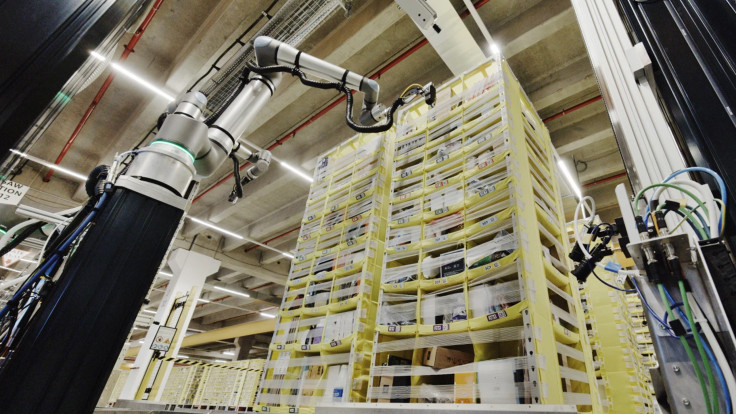Robot Invasion at Amazon? Machines to Outnumber Humans in UK Warehouses Within 3 Years, Expert Warns
Since 2012, Amazon has deployed 1 million robots globally

Thirteen years after Amazon first introduced robotics into its operations and reaching a significant milestone of one million active robots worldwide in fulfilment centres, Amazon's UK warehouses are expected to house as many robots as human workers within three years—a transformation that experts warn could fundamentally alter the employment landscape for thousands of British workers.
According to The Wall Street Journal, Amazon is also nearing a point where its US warehouses will employ more machines than people.
Amazon now has over 750,000 robots deployed
— flint (@OrderflowES) June 30, 2024
Each robot packer at a warehouse can replace 24 workers
Packers cost $1 million each which only takes two years to recoup the cost pic.twitter.com/y2mWlgu3IE
Expert Warns of Impending Robot-Human Parity
Dr. Amir Aly, from the Centre for Robotics and Neural Systems at the University of Plymouth, suggests that Amazon's projected £40 billion UK investment by 2028 indicates a significant increase in the use of robots.
He states, 'The scale of investment indicates there will be a 1:1 ratio of humans to robots in the UK in the next one to three years. It's the money and technology advances that talk in the end.' Dr Amir suggested that the considerable financial input and the government's supportive stance indicate an agreement to foster a 'friendly regulatory environment.'
Robots are already coming for warehouse workers.
— Rowan Cheung (@rowancheung) October 21, 2023
Amazon just revealed a new video showcasing their trial of humanoid robots in US warehouses: pic.twitter.com/RqRIjTNgV1
Professor Sethu Vijayakumar, a robotics expert at the University of Edinburgh, concurred that roles would diminish during the 'temporary friction' of the robotics revolution. He said, 'There will never be as many jobs once warehouses are automated.'
What began as a modest experiment in warehouse automation has evolved into something resembling a science fiction film. Walking through Amazon's modern facilities today, you'll witness an orchestrated dance between man and machine, though increasingly, the machines are taking centre stage.
The scale of this transformation is staggering. Consider this: in 2015, each Amazon employee managed to ship roughly 175 packages. Today, that figure has rocketed to 3,870 packages per worker—a twenty-fold increase that tells the story of how dramatically robotics has reshaped productivity expectations.
Amazon's Stance: Robots Augment, Not Replace
Amazon refutes these claims, highlighting its increased hiring in the UK over the past decade, with employee numbers rising from 7,800 to around 70,000.
Xavier Van Chau, from Amazon's robotics team, stated that instead of replacing workers, the company has trained 700,000 people to operate robots.
He maintained that the company's goal is to free workers from repetitive tasks, 'adding value, not replacing humans.'
Investing in the Workforce: Upskilling for the Future
Since 2019, Amazon has invested in its workforce, helping to upskill over 700,000 employees through various training initiatives. This includes 51,000 individuals in the UK, with many of these programmes specifically designed to prepare staff for working with advanced technologies.
Amazon recently announced its intention to open four new fulfilment centres across the UK. These new facilities will create 60 different types of roles, including specialised positions for robotics technicians and mechatronic engineers.
A Decade of Robotic Evolution: From Kiva to Amazon Robotics
Amazon's venture into robotics began in 2012 with the deployment of its first robot, designed to transport inventory shelves within warehouses. This marked a key moment, stemming from Amazon's acquisition of Boston-based Kiva Systems, a company later rebranded as Amazon Robotics.
This acquisition highlighted Amazon's dedication to advancements in AI and automation. Today, the company utilises a varied fleet of robots, all designed to simplify tasks, improve employee safety, and enhance operational efficiency.
Reaching a Milestone: Amazon Deploys its Millionth Robot
Thirteen years after Amazon first introduced robotics into its operations, the company has reached a significant milestone: one million robots are now active across its worldwide network of fulfilment centres. Amazon announced that its millionth robot was deployed at a fulfilment centre in Japan in June 2025.
Amazon's robotic workforce isn't just growing—it's becoming increasingly sophisticated. Hercules robots now shoulder loads weighing up to 1,250 pounds. Proteus units navigate warehouse floors alongside human colleagues with remarkable precision. The newest addition, Vulcan, possesses something approaching a sense of touch, using six-axis force sensors to handle delicate items.
These aren't the clunky industrial robots of previous decades. They're sleek, intelligent, and increasingly capable of tasks once thought to require human judgement and dexterity.
The Ripple Effect Across Britain
Amazon's automation surge isn't happening in isolation. Competitors like Walmart and Alibaba are scrambling to match these technological advances. What begins in Amazon's warehouses today will likely spread across the entire logistics sector tomorrow.
The company's £40 billion investment will undoubtedly create some jobs—robotics technicians, mechatronic engineers, system analysts. But these highly skilled positions number in the hundreds, whilst the traditional warehouse roles being automated away count in the thousands.
The reality is this: we're witnessing the early stages of a fundamental shift in how goods move from seller to buyer, and human labour is increasingly becoming optional rather than essential.
© Copyright IBTimes 2025. All rights reserved.






















